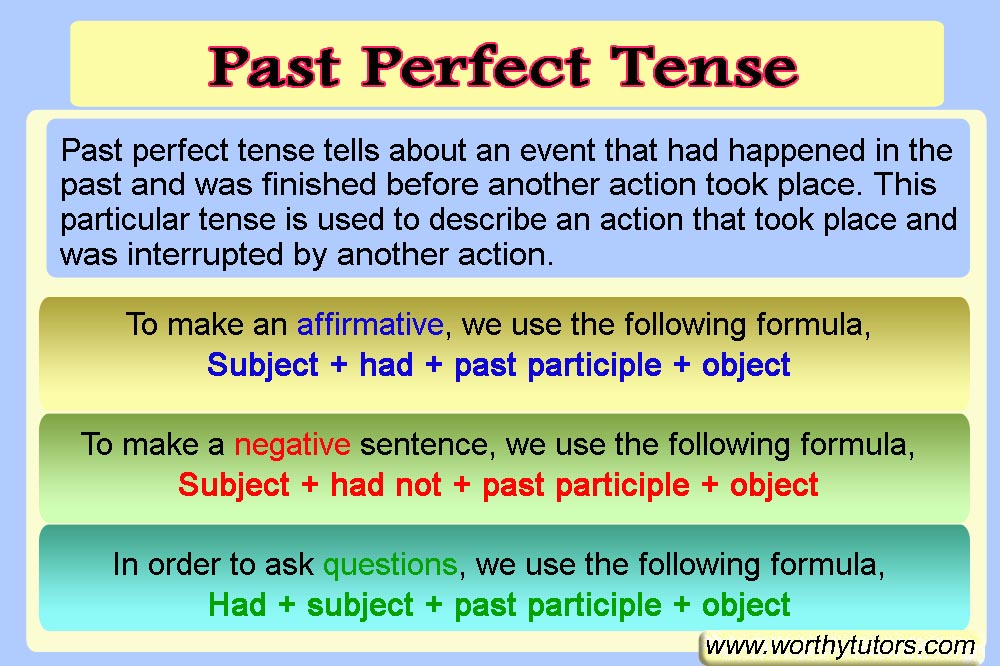
Past Perfect Tense | English Grammar
PAST PERFECT TENSE
Introduction of Past Perfect Tense
Past perfect tense tells about an event that had happened in the past and was finished before another action took place. This particular tense is used to describe an action that took place and was interrupted by another action.
For Examples,
· Kylie and Ella had already met an accident before they could get a hold of the brakes.
· Marcus and Luna had sold their car for a very good price before buying another one.
· I had not saved the file before I turned my PC off.
Past participles (3rd form of verb)
We know that there are three forms of verb. The first form is the base form, the second form is the simple past and the third form is the past participle. How do we form a past participle? There is no hard and fast rule. It differs for irregular and regular verbs.
• Regular verbs
Past participles of irregular verbs can be formed by adding -ed, -d or -t to the base form of the verb. For example, the past participle of burn is burnt, cook is cooked, spoil is spoilt etc.
• Irregular verbs
Past participles for irregular verbs are differently made. We do not just add -e, -d or -t to the base form. Past participles of irregular verbs need to be memorized. For example, the past participle of take is taken, shake is shaken, think is thought, break is broken etc.
Forming sentences in the past perfect tense is quite easy if you are well acquainted with the past participle (3rd form) of verbs.
Formula to form sentences in Past Perfect Tense
Once you have memorized the past participles of the verbs, forming sentences in past perfect tense becomes a piece of cake. But building sentences with past perfect tense can still be tricky for many students. Therefor, seek help from grammar check tools to make sure that your sentences are perfect with no grammar mistake. We follow the following formulas to make different types of sentences in past perfect tense.
How to make affirmative sentences in Past Perfect Tense?
In order to make an affirmative sentence in past perfect tense, we follow the following formula.
Subject + had + past participle + object
For example,
· He had eaten the cake all by himself before the guests appeared.
· They had arrived at the party before it even started.
How to make negative sentences in Past Perfect Tense?
In order to make a negative sentence in the past perfect tense, we follow the following formula.
Subject + had not + past participle + object
For example,
· Samantha had not played the movie before her friends arrived.
· Sarah had not known about it until he told her the story.
How to make questions is Past Perfect Tense?
In order to ask questions in the past perfect tense, we follow the following formula.
Had + subject + past participle + object
For example,
· Had Jake arrived at the airport before Layla did?
· Had Justin and Maya studied the topic well before they came to the class?
· Had you practiced playing guitar before coming to the concert?
Use of the terms ‘just’ and ‘already’
We usually use the words already and just in the past perfect tense.
Just is used when the event happens only a short time earlier than before.
For example,
· I had just finished reading a book before the light went out.
· We had just finished eating an ice-cream before he brought another one.
· Jade and Lily had just finished cleaning the house when the storm approached.
Already is used to serve the basic purpose of the past perfect tense, that is, to show that an action took place before another action.
For example,
· Jenny had already taken the money before someone else could.
· Lisa and Jordan had already left the meeting when the CEO arrived.
You Might Be Interested In
- Simple Past Tense
- Past Continuous Tense
- Past Prefect Continuous Tense
- Simple Present Tense
- Present Continuous Tense
- Present Perfect Tense
- Present Prefect Continuous Tense
- Simple Future Tense
- Future Continuous Tense
- Future Prefect Tense
- Future Continuous Prefect Tense
English Grammar
Tenses
Punctuation Marks
Parts of speech
Writing skills
Public Submissions
Testing/Exam
Grammar Rules
English Vocabulary